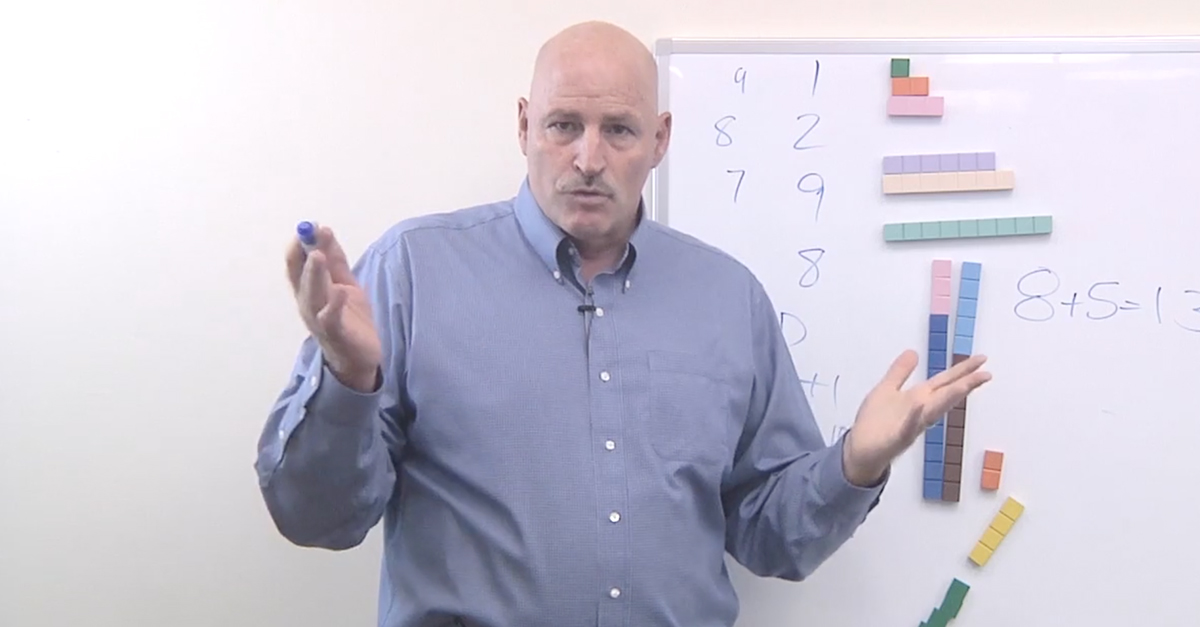
Math-U-See founder Steve Demme took some time to talk about Math-U-See’s philosophy in his own words. He also provides some great strategies for nailing down those math facts. Here’s what he had to say:
I’m going to start with a quick summary of the Math-U-See philosophy. This will be helpful for those who don’t know about Math-U-See, as well as current customers.
One of the goals of Math-U-See is to teach students to understand math as well as know how to do it. In Math-U-See, we have 30 lessons per level. In what I would call general math or the elementary level, we start in Alpha, which is just single-digit adding and subtracting. I’ll be referring to that book a lot today. And then we do Beta, which is multiple-digit adding and subtracting. And then we teach Gamma, which is all multiplication from facts all the way through multiple-digit multiplication. Those three books, though, are the first three in our series, and each of those books has 30 lessons; Math-U-See typically only teaches one topic per lesson.
What we want you to do is to master the material in each lesson, so you move through the book progressively. You’re moving from a position of confidence, because you’ll have mastered this, and then you’re only going to learn one new thing each lesson. Some textbooks give you three or four topics per lesson, and they’ll go all over over the place, and we’re not going to do that. We’re going to give you one thing at a time, and usually, those are pretty bite-sized chunks. If you can focus on one lesson at a time, get the material in that lesson before you move to the next lesson, you’re going to have a happy kid, you’re going to have a confident kid, and you’re going to have a student that really has had a chance to build up his self-esteem.
When we teach math facts, we spread out the addition facts over several different lessons. I’m going to go through the addition sequence, but this whole concept of Math-U-See is line upon line, precept upon precept, here a little, there a little, that’s exactly what we’re trying to do. Math-U-See provides several different ways that we can teach math fact memorization; I’ll be showing you this later.
One question I get a lot is what the parent is responsible for in the math instruction. Math-U-See is just a curriculum, and you are the teacher. What Math-U-See does is give you the information and the tools so that you can present them to your student for the best success; I think this is a cooperative effort. You can even have your kids watch the Math-U-See videos with you if you like. You know your child, and you know best how they learn, how fast or how slow you should go, and where they need help and reinforcement. I’m counting on your expertise to apply it properly, and you’re counting on our expertise to give you the tools to teach math.
One of the things that we do at Math-U-See is to give you several different ways to teach, and you have to choose which one fits your student the best, which one clicks. Teach to a child’s strengths, but build up their weaknesses.
How would I apply this?
If I have a child that’s an auditory learner, I would be doing a lot of auditory input. Instead of just using blocks all the time, I’d be doing a lot of verbalizing the information. I would say, “3+3 is the same as 6. 3+3 = 6. 6 is the same as 3+3.” I’d be putting that into their ears, because if they learn better with the ear, then you want to teach that way.
If a child is a visual learner, the same thing happens. I would teach them visually. I’d find something that works for them and they go, “Oh, I get it. That’s just really helpful.” But I would continue to verbalize, at the same time.
If the building helps your child the most, maybe lean a little bit that way, when you’re emphasizing the new material. If verbalization is helpful, great. But most math that children are going to see is going to be written, and that’s why you need to take this, verbalize it, and illustrate it. Whichever one of these is going to help you the most, great, and maybe your child learns better. We have a family where I live, and they’re a singing family; they make songs out of everything, whether they’re studying geography, grammar skills, etc., and it seems to work for them. You might have a family that you can’t do anything with unless there’s some kind of a story. For example, one of the facts that I teach, I learned from a boy named Josh, who said, “I ate and ate ’til I was sick on the floor. 8×8 is 64.” I wish I could make a poem up, and I spent hours one day trying to think of poetry for 7×7, 7×6, some of the hardest facts that you teach, and didn’t come up with anything. If you can think of little mnemonics or poems for math that really works for you, post them in the comments.
Memorizing Math Facts Video
Let me just show how we teach in a short 19-minute video; I’m going to go through the addition facts.
Probably the biggest obstacle I find among parents is the pressure to conform to what their peers or educators think they should be covering, and when. Let your child have the time that he needs and learn the information that he needs. It’s much more important that you move at the child’s pace than to conform to outside influences. Don’t worry about being behind; focus on teaching your child at their pace.
We Are Here to Help
If you have questions about teaching math, we are here to help!
Get in Touch



My 3rd grade teacher thought us 7 x 7 by saying: “what is 7 feet wide by 7 feet tall? The 49er’s football team”
And than she said you can remember 7×6 because we memorized 7×7 is 49, and 49-7=42. You minus 7 from it because the difference between 7 and 6 is 1, and you would multiply 1, 7 times to give you 7.
We also learned: 8 and 8 fell on the floor, when they got up they were 64!
Can you make one of these for multiplication too??
My kids need a refresher crash course reminding them!
Cassie Deputie check out this video on multiplication here: https://demmelearning.com/learning-blog/category/free-homeschool-math/
Hi Cassie,
Check out this post on multiplication — hope it helps!
Thanks for the video! It was so helpful for my kindergarten and my co-op class math class I’ll be teaching this winter.
My son still remembers learning the sevens multiples using the tune of “Happy Birthday” when he was in fourth grade. He is 27 and can still sing the song without skipping a beat!